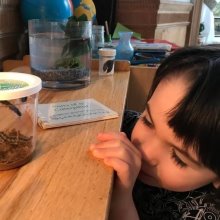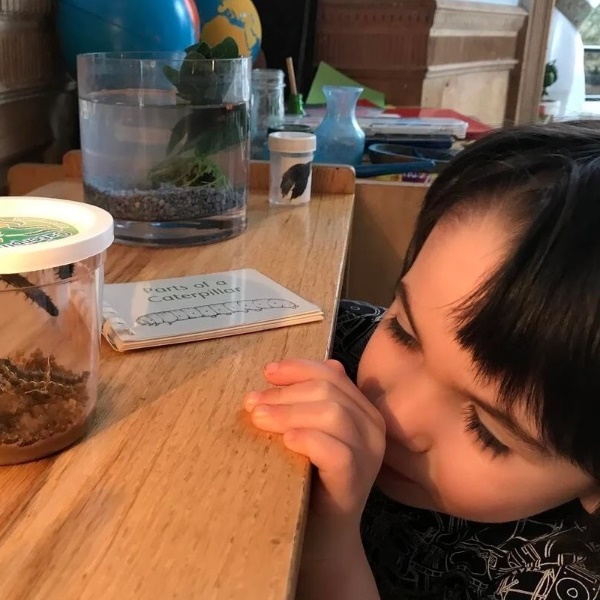
This article was originally written by former Kingsley Early Childhood Lead Teacher Laura Beaudry, and printed in the Spring 2018 issue of The New Kingsleyan.
MONTESSORI CULTURAL LEARNING
The Montessori Cultural area at the Early Childhood level is broad in content, yet specific in its intention. It is through the Cultural curriculum that young children develop impressions about how the world works.
Sensory Years - The years between birth and age six are largely unconscious ones. At this time in their development, children sense and manipulate their surroundings, first with their mouths and then with their hands, in order to gain understanding. This period of development is considered the sensory years, when children absorb infinite amounts of information through their senses—sight, sound, touch, smell, and taste—and then internalize that information as deep sensory knowledge. Maria Montessori said that children in this age group have absorbent minds, because they seem to take in information effortlessly; these are the years when lasting impressions are made.
EARLY CHILDHOOD CULTURAL CURRICULUM
The Early Childhood Cultural curriculum encompasses geography, zoology, botany, physical science, and history. As an introduction to physical geography, two globes are used. One globe represents land and water areas, showing the land as rough brown sandpaper and the water as a smooth blue painted surface. The second globe introduces the seven continents—each is shown in its own distinct color. Children learn the names and location of each continent. The same colors of the continents carry over to the Puzzle Map of the World and into the continent materials used in Lower Elementary.
- Geography - The large wooden Puzzle Maps are popular activities in the classroom. The child puts each puzzle piece into place by means of a little knob. The introductory map of the world has a separate puzzle piece for each continent. After working with the world map, the child can explore the six continent puzzle maps, in which each country is represented by a separate puzzle piece. There is also a map of the United States with a separate piece for each state. As they manipulate these puzzles, children learn about several countries located on each continent. Teachers provide objects, photos, culture-specific music, foods, and art activities that represent particular countries and cultures of study.
- Zoology - To begin their exploration of zoology, children are introduced to the concept of living vs. nonliving. Teachers read books about and discuss the needs of living things: soil, air, and water, and often exhibit real objects that the children can hold and study. Children create categories using objects and photographs, dividing them into groups of living and nonliving things, plants and animals, vertebrates and invertebrates. Finally, the five vertebrate classes—fish, amphibian, reptile, bird, and mammal—are introduced. Children learn about the variety of animals in each group, their distinct features, the names of their body parts, and their habitats.
- Botany - Botany is introduced using large knobbed puzzles of a tree, a leaf, and a flower that separate each part of the plant into a distinct puzzle piece. Children learn the names for each part of a tree, leaf, and flower. Working with these materials helps children to become more observant of the characteristics of things that grow in their own environments. We frequently have plants, flowers, or vegetables growing in the classroom.
- Physical Science - Physical science is introduced by way of real things from nature displayed throughout the classroom. Children explore different kinds of rocks, shells, and other specimens using a magnifying glass. They conduct simple experiments to help them explore such concepts as “sink and float,” “magnetic and nonmagnetic,” “transparent and opaque,” and “solid, liquid, and gas.” A constantly rotating curriculum provides the opportunity for children to explore other areas, such as the solar system, volcanoes, and the weather.
- History - History is introduced in a very personal way in Montessori classrooms. Each child is assigned a special day every year, close to or on his/ her birthday, for a Birthday Walk. This uniquely Montessori tradition allows children to enact the process of time by holding a globe while walking around a lit candle representing the sun. For each year of their age, children circle the sun. Afterward, they show the class photographs of themselves at each age. Teachers then display the photos in the classroom in a variety of ways, often showing the history of each child’s life by displaying them as a timeline on the classroom wall.
CULTURE
The Cultural curriculum introduces children to the physical world of plants and animals, the exploration of differences and similarities among people, and the opportunity to see, hear, taste, smell, and manipulate the real things that make up their unique cultural environment. While exploring the rich content of the Cultural area, young children are unconsciously building skills in observation, prediction, sequencing, categorizing, questioning, organizing, comparing, and contrasting. These developing skills will be used at the Elementary level when the Cultural curriculum becomes more abstract and subject to critical thinking. As is the case in all of the Montessori curriculum areas, the content is used as a means to develop thinking and learning skills.







.jpg&command_2=resize&height_2=85)








.jpg&command_2=resize&height_2=85)
.jpg&command_2=resize&height_2=85)




